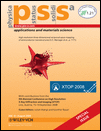Multi-layer thickness determination using differential-based enhanced Fourier transforms of X-ray reflectivity data
Abstract
Layer thickness determination of single and multi-layer structures is achieved using a new method for generating Fourier transforms (FTs) of X-ray reflectivity data. This enhanced Fourier analysis is compared to other techniques in the determination of AlN layer thickness deposited on sapphire. In addition to demonstrably improved results, the results also agree with thicknesses determined using simulations and TEM measurements. The effectiveness of the technique is further demonstrated using the more complicated metamorphic epitaxial multi-layer AlSb/InAs structures deposited on GaAs. The approach reported here is based upon differentiating the specular intensity with respect to the vertical reciprocal space coordinate QZ. In general, differentiation is far more effective at removing the sloping background present in reflectivity scans than logarithmic compression alone, average subtraction alone, or other methods. When combined with any of the other enhancement techniques, however, differentiation yields distinguishable discrete Fourier transform (DFT) power spectrum peaks for even the weakest and most truncated of sloping oscillations that are present in many reflectivity scans from multi-layer structures.




